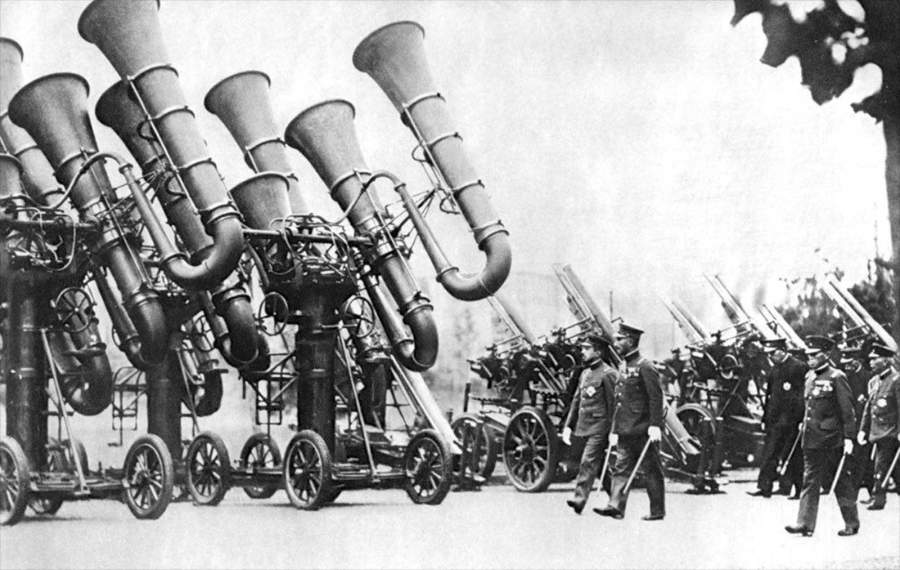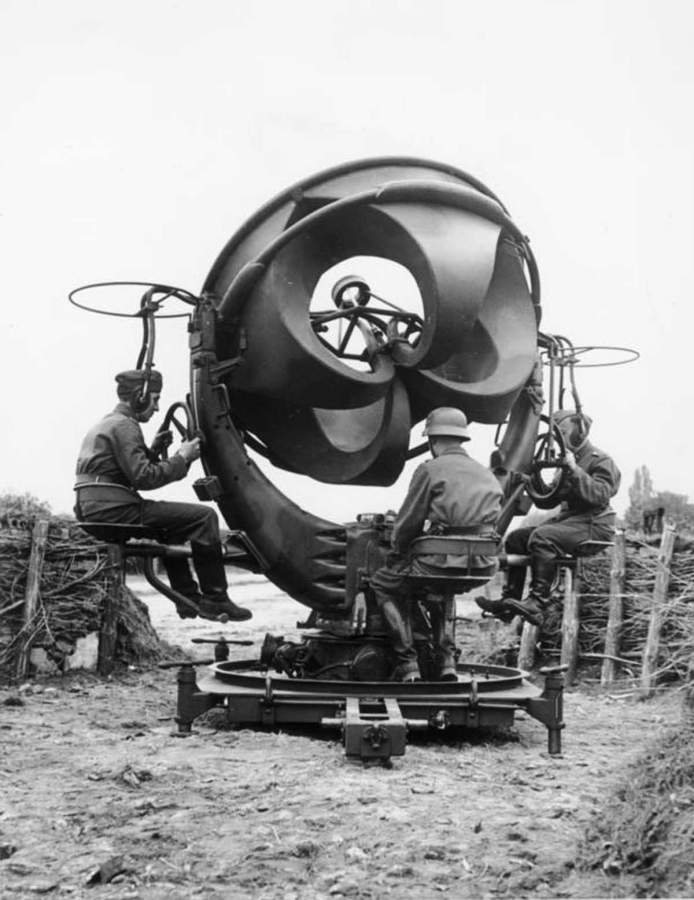In the course of attempting to identify an apparent dish-like object in a photograph from WWII, I did a confirming search for “Japanese anti-aircraft radar.” That led me over to “early aircraft detection systems” and some really interesting pictures out of what look like steampunk-land. [source]
Child: “What did you do during the war, daddy?”
Father: “I wore a strange thing on my head all day.”

I wonder about the eye-cups? Was the idea that if the sensor-truppen were blindfolded that they would pay better attention?
It seems silly now but it was serious business, then. Aircraft were the eyes of the military, and compared to today’s military jets, they were fairly stealthy in terms of sound.

I wonder how they protected the soldiers’ hearing if there was artillery? Wait; this was World War I – they probably just told the soldier it was orders.

You’ve possibly already seen this picture; it’s been posted various times as an example of military “WTF” – but it’s imperial Japanese army aircraft detection system, prior to radar.

Armored vehicles on the move are quite loud. The unit above, pictured in 1939, may have been listening for French tanks. Or perhaps a soldier muttering “Merde, alors!” The German unit above appears to be set so the ‘sensor units’ can tell the operator (in the center) what they are hearing, and the operator can triangulate on a map in the center.
Today’s military still have detector networks, they’re just smaller and lots, lots better.
A funny thought occurs to me: since F-35s are stealthy, but usually fly below the speed of sound (supersonic/supercruise gobbles fuel), these old machines would possibly be useful to detect an incoming stealth F-35 strike. If any of you want to propose to manufacture these, you could probably get a billion dollars from The Pentagon to “research” it.

A Swedish ice weasel detector

I re-watched Pentagon Wars the other night; I had forgotten how close to the bone it cut. At one point, it referred to the Sergeant York radar-controlled antiaircraft gun, and how it failed testing – “it opened fire on a bathroom fan and successfully destroyed it.” That was actually an incident that actually occurred! The Sergeant York was crap and everyone knew it but there were too many defense dollars at stake. Of course, the Sergeant York scammers were rank amateurs compared the folks running the F-35 program.

That 3rd pic is probably the steampunkiest IRL thing I’ve ever seen. Looks straight out of Girl Genius.
The 4th pic is, to me, simply beautiful. The main body looks more like a sculpture than a machine.
First picture, I think that might be for artillery counter-fire. The small-aperture goggles possibly make flashes more visible by reducing the amount of light to eye. You could estimate range by measuring the time between spotting the flash and hearing the boom.
The only possible use I could think of the goggles in an anti-aircraft role would be as pin-hole glasses to prevent squinting while looking for the plane.
Maya@#2:
First picture, I think that might be for artillery counter-fire. The small-aperture goggles possibly make flashes more visible by reducing the amount of light to eye. You could estimate range by measuring the time between spotting the flash and hearing the boom.
That sounds really plausible. So, they’re artillery counter-battery spotters.
This reminded me that it had been over two years since the last time I watched a movie. I hardly ever watch them, the movie format simply doesn’t work well for my brain (meaning: movies bore me). Anyway, since the “comedy that doubles as social critique” genre is among the few movie genres that my brain is capable of appreciating, I decided to give Pentagon Wars a try. I just finished watching it, I liked this movie, it was fun. I presume that it was also factually pretty close to how things are happening in real life.
In the first picture, I like the faint smile of the guy on the right. To me, it says “I know I look supremely silly, but hey, I’m not in the trenches, so who’s silly now?”
With the third and fourth pictures, I now know where Dr Seuss came up with his ideas.
brucegee1962 @ #5
He does look just like that.
In the fourth picture I couldn’t help wondering what happens if the listeners disagree about which way to swivel the listening bit, or if they get a bit giddy and try to spin it really fast, do their seats swing up like those fairground roundabouts?
With some modifications No. 3s could perhaps be used to create the world’s loudest brass orchestra. I wouldn’t rule out military applications either. (A possible counter-measure to its unmodified ancestor?)
—
On the upside that contraption (No. 2) probably offers at least as much protection as the average infantry helmet at the time. (What would a richochet inside one of those ear cups sound like, I wonder? Though you’d have to be both very lucky and unlucky to get to hear it an be able to describe it afterwards)
—
Re: Jazzlet (#6):
I wondered about that, too. Maybe the third man’s only job is to yell at them if they can’t agree. It would a very military solution, especially in terms of efficiency. Wherever there are two or more soldiers you need an officer to shout at them, lest they do (the wrong) stupid things.
brucegee1962 @ # 5 – I wonder if “guy” is the right word there…
During the Vietnam war the VC and NVA would dig shallow concave ‘caves’ into hillsides. Our side found these somewhat mysterious, maybe badly designed shelters? abandoned caches or fortifications? Nope – you could stand or sit inside the concavity and hear approaching helicopters long before someone else only a few feet away from the ‘cave’.
My cabin is firmly planted on bedrock on a mountain ridge, the whole house is a sounding board – I can hear far away trucks, trains, planes, and copters inside sooner than I can hear them outside. We also feel the slightest earthquakes – yes I was surprised at the idea of earthquakes in the southern appalachians too, but it happens every couple years.
The British used some pretty impressive looking “sound mirrors” before radar came along.
http://www.andrewgrantham.co.uk/soundmirrors/
Pierce R. Butler #8
I think you are correct.
Ieva Skrebele@#4:
I presume that it was also factually pretty close to how things are happening in real life.
They do some shenanigans – things like having the target unfueled during testing, etc. – that’s passed off as basic range safety, not cheating. I think the bulk of the procurement scams is in the process – how they define “ready” and how they block the purchases. Coincidentally, I just queued another piece on the F-35… It’ll drop in a few.
I wondered about that, too. Maybe the third man’s only job is to yell at them if they can’t agree.
In AI, this is how some things are actually done: you have more neural networks and put them into a hierarchy then choose based on a central network that is trained to decide between networks. So, that German rig may be “prior art” – actually, the Space shuttle’s computers did the same thing, except at the granularity of entire computer systems agreeing.
@ 4 Ieva Skrebele
I presume that it was also factually pretty close to how things are happening in real life.
I had never heard of the film before but I watched about half of it last night. Allowing that there is a bit of “dramatic” over-exaggeration, it seems about right.
I am looking forward to Marcus’ posting on the F-35. It has become one of the worst fiascos for a military acquisition in memory.
I have read a rumour (possibly even true?) that the US navy was, at one time, considering buying Sukhoi SU-27 (Su-24?) airplanes as a stop-gap measure until the F-35 might become operational.
There are some F-35s in service but they are flying with massive defects lists. One gets the feeling that they are, figuratively, held together with chewing gum and duct tape.